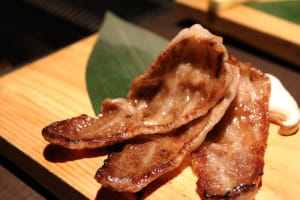Kyoto is Bakery Mecca for both Bread Lovers and Bakery Fanatic

Town of Bread Lovers, the not well known aspect of Kyoto.

Kyoto has been know as a city of classical and beautiful image that conveys Japanese tradition to the present.
So, it may be surprising to imagine that there are quite many bread lovers living in Kyoto, so much that their consumption has been the top in the country!
In some neighborhood, you will smell slightly sweet fresh out of oven bread every several hundred 100m ! There are so many delicious bakeries unique in style in Kyoto. You will definitely find your favorite shops.
The King of the Bread, Japanese Soft White Bread "Shokupan "

This simple white bread is a staple of daily breakfast scene in Japan, and one of the items that is going fast at almost every bakery.
In recent years there are much effort in bring out different flavor and texture of this simple traditional bread in new ways. The ones that are more "Mochi-mochi (moist)" and fluffy in texture has been popular, and some bakeries even arrange them in to a cake type of sweet bread.
There is also ones that are baked using only high grade ingredients. This type of bread is more high in price, but gaining popularity as a gift. This evolution of the simple staple break fast bread is absolutely adding another layer of charm to the king of bread.
Great Snack Time with " Kashipan (sweet bread) "

Another Japanese's unique contribution to nurturing love for bread and culture is creation of a category of bread called Kashi-pan (Kashi=sweets, Pan=bread). These sweet breads usually baked with sweet coating or flavoring on the surface.
Among all different types of Kashi-pans, nothing can beat the classic "An-pan". This bread is filled with sweet red azuki bean paste, which is also the major ingredient for Japanese sweets. It goes amazingly well with coffee as well as green tea. This rather old An-pan has a special place in people's live and seemed to be loved by all generations.
Back Ground of the Big Bread Culture in Kyoto

Kyoto's cultural development is deeply rooted and supported by craftsmen and merchants who sold these artcrafts to aristocrats for many hundreds of years.
There are still those merchants and craftsmen who have been carrying on the remnants of the past tradition. One could say they are the ones who actually have been loving having bread for casual snacking or meal during working.
Unlike proper Japanese meal with chopsticks, bread is quicker and only requires one hand to eat. This has become such handy and perfect food for them that takes less time out of hectic working life style.
These craftsmen and merchant might have been contributed to the current bread food culture.
However there is another aspect to support the bread culture here, which is a particular characteristics of Kyoto people. They love practical and new things.
There is alway new bakery opening somewhere in town, and so many of them are baking in unique setting from old grandma place to stylish western baking shops. You will never get tired trying out different bakeries.
How to "Eat-in (having the bread right there at the bakery)" ?

In Japan, eating and drinking in the store you have just made purchase of is called "eat-in". It has different meaning in English, so just be aware that this term gets used to indicate eating in the store or restaurant in Japan.
Tables and chairs are set up in the store for you to sit down and have fresh out of oven goodies.
Related post
-

Steak House Pound (Shijo Omiya): A comfy place to savor tender Japanese BBQ
-
 Shopping
ShoppingFusion on tradition and new Japanese food! Kyoto style tenmusu
-
 Activities
ActivitiesA new lifestyle from Kyoto! Enjoy items that are good for mind and body at GOOD NATURE STATION
-
 Food/Drink
Food/DrinkI want to try sake from Kyoto! An introduction to drinking sake in Kyoto

 English
English 日本語
日本語 한국어
한국어 简体中文
简体中文

